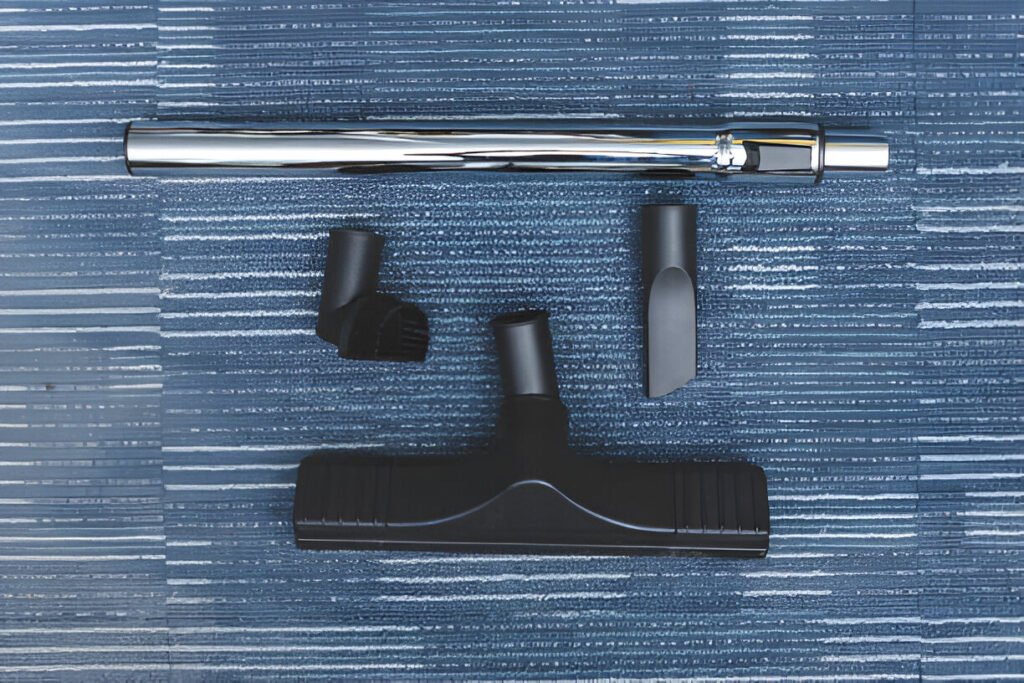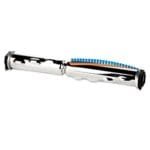Replacing vacuum cleaner belts involves removing the old belt and installing a new one. Follow these steps for optimal performance.
Maintaining your vacuum cleaner ensures it runs efficiently and prolongs its lifespan. One essential maintenance task is replacing the vacuum cleaner belt. Over time, belts can wear out, stretch, or break, leading to reduced suction and cleaning performance. Regularly checking and replacing the belt is crucial for keeping your vacuum in top condition.
This step-by-step guide will walk you through the process, making it easy even for beginners. Proper maintenance not only enhances cleaning efficiency but also saves you money on repairs and replacements. Keep your vacuum operating at its best with these simple steps.
Tools And Materials
Replacing vacuum cleaner belts ensures optimal performance. The right tools and materials make the process easy and efficient. This section covers the essential tools and how to choose the right belt.
Essential Tools
Gather these tools before starting the replacement process:
- Screwdriver: A Phillips or flathead screwdriver, depending on your vacuum model.
- Replacement Belt: Ensure it matches your vacuum’s model number.
- Scissors or Utility Knife: For cutting the old belt if needed.
- Soft Brush: To clean the vacuum’s internal parts.
- Cloth: A soft cloth for wiping dust and debris.
Choosing The Right Belt
Choosing the correct belt is crucial for optimal performance. Follow these steps:
- Check your vacuum’s model number. It is usually on the bottom or side.
- Refer to the user manual. It lists compatible belt types.
- Visit the manufacturer’s website. They often have a parts section.
- Purchase from a reputable retailer. Ensure the belt matches your vacuum model.
| Step | Action |
|---|---|
| 1 | Identify your vacuum’s model number. |
| 2 | Check the user manual for belt types. |
| 3 | Visit the manufacturer’s website for parts. |
| 4 | Buy from a reputable retailer. |
Using the right tools and materials ensures a smooth belt replacement process. This enhances your vacuum’s performance and longevity.

Safety Precautions
Replacing your vacuum cleaner belt can greatly improve performance. But first, you must follow some essential safety precautions. These measures ensure you avoid injury and keep your vacuum in good condition.
Unplugging The Vacuum
Before you begin any maintenance on your vacuum cleaner, always unplug the device. This simple step prevents electric shock and accidental start-ups. Make sure the vacuum is completely powered off before proceeding.
Handling Components Safely
When handling the vacuum components, ensure your hands are dry. Wet hands can lead to slips and accidents. Use tools designed for this purpose to avoid damaging parts. Keep a small container nearby to hold screws and small parts.
| Safety Measure | Description |
|---|---|
| Wear Gloves | Protects your hands from sharp edges. |
| Secure Workspace | Ensure your workspace is stable and well-lit. |
- Read the Manual: Always refer to the vacuum cleaner’s manual for specific instructions.
- Inspect Components: Before replacing the belt, check for other worn-out parts.
- Use Proper Tools: Using the right tools prevents damage to your vacuum.
- Turn off and unplug the vacuum cleaner.
- Disassemble the necessary parts carefully.
- Remove the old belt and replace it with a new one.
- Reassemble the vacuum and plug it back in.
By following these safety precautions, you ensure a smooth and safe belt replacement process. Proper care extends the life of your vacuum cleaner and keeps it running efficiently.
Accessing The Belt
Replacing your vacuum cleaner belt ensures optimal performance. This guide helps you access the belt step-by-step. Follow these instructions carefully to maintain your vacuum’s efficiency.
Removing The Cover
First, unplug your vacuum cleaner. Safety is paramount.
Next, locate the screws holding the cover. Use a screwdriver to remove them. Keep the screws in a safe place.
Gently lift the cover off. Be cautious not to break any clips.
Locating The Belt
With the cover removed, you can see the internal components.
Find the brush roll. The belt usually connects the brush roll and motor.
Check the belt for wear and tear. If damaged, it needs replacement.
Take note of how the belt is positioned. This helps during reinstallation.

Removing The Old Belt
Replacing your vacuum cleaner belt can improve its performance. Start by removing the old belt. Follow this step-by-step guide to ensure you do it correctly.
Loosening Screws
First, find the screws on the vacuum’s bottom plate. Most vacuums have 2 to 4 screws. Use a screwdriver to loosen these screws. Keep the screws in a safe place.
Once the screws are loose, gently lift off the bottom plate. This will expose the belt and brush roll. Be careful not to damage any parts.
Taking Out The Belt
Now, locate the belt on the brush roll and motor shaft. The belt may be worn out or broken. Carefully slide the belt off the brush roll first.
Next, remove the belt from the motor shaft. Sometimes, the belt may be stuck. Use gentle force to avoid breaking any parts.
Inspect the brush roll and motor shaft for any debris. Clean these parts if necessary. This ensures the new belt will work smoothly.
| Step | Action |
|---|---|
| 1 | Loosen screws on the vacuum’s bottom plate. |
| 2 | Lift off the bottom plate gently. |
| 3 | Slide the old belt off the brush roll. |
| 4 | Remove the belt from the motor shaft. |
| 5 | Inspect and clean the brush roll and motor shaft. |
Installing The New Belt
Replacing your vacuum cleaner belt can improve its performance. Follow these steps to install the new belt easily.
Positioning The Belt
First, locate the motor shaft of your vacuum cleaner. The new belt will loop around this part. Carefully slip the belt over the motor shaft. Ensure the belt is aligned straight and has no twists.
Next, find the brush roll. This is where the other end of the belt will go. Slide the belt onto the brush roll. Make sure it fits snugly.
Securing The Belt In Place
Now, you need to secure the belt. Pull the belt towards the brush roll. Stretch it gently to fit over the motor shaft. The belt should be tight but not too stretched.
Once the belt is in position, rotate the brush roll by hand. This ensures the belt is seated correctly. The brush roll should turn smoothly.
Finally, reassemble the vacuum cleaner. Put back any covers or screws that you removed earlier. Plug in the vacuum and turn it on to test the belt.
| Step | Action |
|---|---|
| 1 | Locate the motor shaft |
| 2 | Slip the belt over the motor shaft |
| 3 | Slide the belt onto the brush roll |
| 4 | Secure the belt by stretching it |
| 5 | Rotate the brush roll to check alignment |
| 6 | Reassemble the vacuum cleaner |
Following these steps will help you install the new belt correctly. This ensures optimal vacuum cleaner performance.
Reassembling The Vacuum
Once you’ve replaced the vacuum cleaner belt, the next step is reassembling the vacuum. This process ensures your vacuum is ready for optimal performance. Follow these steps carefully to avoid any mishaps.
Replacing The Cover
Start by placing the cover back onto the vacuum’s base. Align the cover with the designated slots. Make sure it fits snugly over the belt and brush roller.
- Ensure all components are aligned correctly.
- Press down gently to secure the cover.
- Check for any gaps or misalignments.
Tightening Screws
Next, locate the screws that secure the cover. Use a screwdriver to tighten each screw. Make sure they are firmly in place.
- Insert each screw into its designated hole.
- Turn the screwdriver clockwise to tighten.
- Ensure all screws are equally tight.
| Step | Action |
|---|---|
| 1 | Align the cover with the slots. |
| 2 | Press down gently to secure it. |
| 3 | Insert and tighten screws. |
Once all screws are tightened, your vacuum reassembly is complete. Test the vacuum to ensure it’s working properly. Enjoy your vacuum’s optimal performance with the new belt!
Testing The Vacuum
After replacing the vacuum cleaner belt, it’s crucial to test the vacuum. This ensures it’s working correctly. Testing helps identify any issues before regular use. Follow these simple steps to test your vacuum cleaner effectively.
Plugging In And Turning On
First, plug the vacuum cleaner into a power outlet. Ensure the plug fits securely. Next, locate the power button on your vacuum. Press the power button to turn on the vacuum. Listen for any unusual noises. These could indicate a problem.
Checking For Proper Operation
After turning on the vacuum, check its suction power. Place your hand near the vacuum’s nozzle. You should feel a strong suction. If not, there may be an issue with the belt installation. Also, inspect the brush roll. It should spin smoothly. A stationary brush roll may indicate a belt problem.
Next, move the vacuum across the floor. Ensure it picks up dirt and debris effectively. If the vacuum struggles, recheck the belt. Make sure it’s correctly positioned.
Finally, look for any unusual vibrations or sounds. These can signal a misaligned belt or other issues. Turn off the vacuum immediately if you notice anything abnormal. Fix the problem before using the vacuum again.
Maintenance Tips
Maintaining your vacuum cleaner is crucial for its optimal performance. Regular maintenance ensures your vacuum works efficiently. Follow these maintenance tips to keep your vacuum in top shape.
Regular Belt Checks
The vacuum belt is essential for its proper function. Regularly checking the belt can prevent issues. Follow these steps to check your vacuum belt:
- Unplug the vacuum cleaner.
- Remove the vacuum’s bottom plate.
- Inspect the belt for wear and tear.
- Replace the belt if it appears worn or damaged.
Perform these checks at least once a month. This ensures your vacuum remains in good working condition.
Cleaning The Vacuum
Cleaning the vacuum is vital for maintaining optimal performance. Follow these tips to clean your vacuum effectively:
- Empty the Dust Bag: Regularly empty the dust bag or canister. This prevents blockages and maintains suction power.
- Clean the Filters: Clean or replace filters as needed. Dirty filters can reduce efficiency.
- Check the Brush Roll: Remove any tangled hair or debris from the brush roll. This helps the vacuum clean effectively.
- Wipe the Exterior: Use a damp cloth to wipe down the vacuum’s exterior. This keeps it looking new.
Regular cleaning ensures your vacuum performs at its best. It also extends the lifespan of your vacuum cleaner.
| Task | Frequency |
|---|---|
| Check Belt | Monthly |
| Empty Dust Bag | Weekly |
| Clean Filters | Monthly |
| Check Brush Roll | Weekly |
| Wipe Exterior | Monthly |
Frequently Asked Questions
How Can I Improve My Vacuum Cleaner Performance?
To improve vacuum cleaner performance, clean or replace filters regularly. Empty the dustbin frequently. Check for blockages in hoses and brushes. Use the correct attachments for different surfaces. Maintain the motor and moving parts.
How To Replace A Belt In A Vacuum Cleaner?
To replace a vacuum cleaner belt, unplug the vacuum, remove the cover, take out the old belt, install the new belt, and reassemble it.
How Do You Know If Your Vacuum Needs A New Belt?
Your vacuum may need a new belt if it isn’t picking up debris, makes unusual noises, or the brush roller isn’t spinning.
How Often Do You Need To Replace A Vacuum Belt?
Replace a vacuum belt every 6 to 12 months. Check for wear or damage regularly to ensure optimal performance.
Conclusion
Replacing your vacuum cleaner belt boosts its performance. Follow our step-by-step guide for the best results. Regular maintenance ensures your vacuum runs efficiently. Save time and money by doing it yourself. Keep your home cleaner and fresher with a properly maintained vacuum cleaner.
Enjoy optimal performance with these simple steps.





